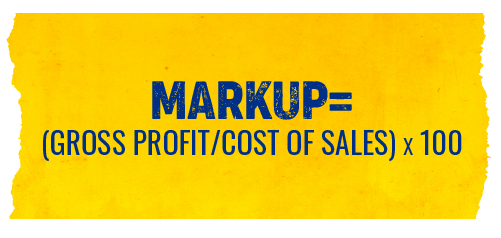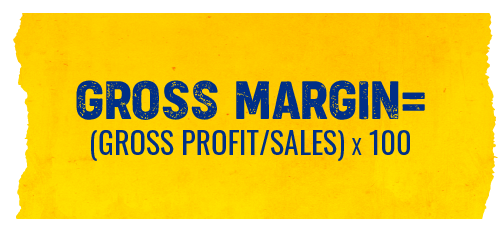One of the worst mistakes you can make with your business is not understanding your cash flow. What are your inventory and labour costs? How much is your gross and net revenue? Basically, where is your money going? Two key metrics for determining your business's health are markup and margin. These are used to answer those questions and determine how much money you're spending versus what you're bringing in.
If you're confused about the difference between markup vs. margin. You're not alone. In this blog, we'll cover their definition, related terms and how to calculate them, as well as how to determine the right profit margin for your business.
Let's dive in!
Part of the problem with business profit metrics is there are a lot of terms: sales, cost of sales (sometimes known as cost of goods sold or COGS) and gross profit. Before we dive into markup vs. margins, let's first sort out these key terms before we use them in other definitions.
To help explain, imagine you want to know your markup and margin for $10,000 in sales. To make that $10,000, it cost you $4,000 in materials, labour and other resources.
Sales: The money you collect from your customer when you sell something is what we're referring to as "Sales." In the business world, there are a lot of different terms used to mean how much money a company makes (e.g. revenue, profit, EBITDA ). But to calculate markup vs. margin, you only need the raw invoice totals, or sales. For our example, that's $10,000.
Cost of Sales: The cost of sales is how much it cost you to make the sales you're basing your other calculations on. Costs can include anything from labour, materials or any other job-specific costs such as subcontractors or equipment. For our example, the cost of sales is $4,000.
Gross Profit: In the simplest terms, profit means how much money you made. There are several definitions once you get further in the weeds, but for markup and margin, all we care about is gross profit. Luckily, this is one of the simplest equations: Gross Profit = co[Amount of Sales] - [Cost of Sales]. So, using our example of $10,000 in sales that cost $4,000 to make, the gross profit is $6,000.
So the numbers look like this: ($6,000/$4,000) x 100 = your markup. If you got 150% as your markup, you're absolutely right.
What is markup?
Let's say our $10,000 in sales from our previous example is from selling a new HVAC unit. That unit cost your business $4,000. That's $6,000 in gross profit. To figure out how much you marked that unit up (the markup), the formula is below.
So the numbers look like this: ($6,000/$4,000) x 100 = your markup. If you got 150% as your markup, you're absolutely right.
What is margin?
While markup is determined based on how much something costs you, margin is calculated using your total sales. Using our same example of the $4,000 HVAC unit that you sold for $10,000, your gross profit is still $6,000. (formula below)
So, gross margin = ($6,000/$10,000) x 100. That's a 60% gross margin for our example.
Unpacking the Difference Between Markup and Profit Margin
As we discussed earlier, terms about business financials can easily get confusing. Talking about markup vs. profit margin vs. profit can make your head spin. Let's see how these three metrics play out in an example:
Markup vs. margin example: the bathroom renovation
You recently completed a bathroom renovation job, amounting to $40,000. Labour cost $22,500 and materials cost $12,000. Let's calculate the markup and margin.
Gross Profit: $40,000 - ($22,500 + $12,000) = $5,500
Markup: ($5,500/$34,500) x 100 = 16%
Margin: ($5,500/$40,000) x 100 = 14%
Visualising the Differences: Markup vs. Profit Margin Chart
Markup should always be larger than margin. If it's not, you've either made a calculation error or something is very wrong with how you're pricing your products and services.
The Ideal Numbers: What Profit Margin Should You Aim For?
Pricing varies for every business, and a lot of factors go into how you set your prices. Everything from how much competition you have (and how good they are), your customer sentiment and reviews, to how much your supplies and employees cost. This means there's no magic number for the "right" profit margin. Additionally, if you aim too high with your margin, you'll likely outprice yourself, losing business. But set your prices too low, and you may have an influx of business that you can't keep up with, burning you and your team out.
It's also important to consider, much like with our examples above, your profit margin can differ depending on what services you offer. It'll likely differ even between jobs and will most certainly change over time. Selling physical products generally have thinner margins than services, with many businesses opting for maintenance plans as their "cash cow."
Let's look at a few industries and their average profit margins. Restaurants traditionally run on very thin margins, often only 3-5%, while construction companies top out closer to 7%. Technology companies often have much larger margins, sometimes reaching upwards of 50%.
To find your business's ideal profit margins, you'll need to take a good look at your books, where you spend your time and money, and create the right balance for all the services you offer.
Reducing Margin Vs. Markup Mistakes
Now that you understand the difference between margin and markup, make sure to use the knowledge to ensure business profitability and growth. Here are some ways you can reduce your mistakes (and math) when calculating these important financial metrics:
Implement a pricing tool to quote sales
When shopping around, one of the first things people often look for is affordability. Clearly seeing an item’s cost, whether it's the installation of a new bathroom or just a new toilet brush, knowing the costs is key. With a field service management software solution, you can provide quotes to customers that detail all the costs involved for a project, no matter its size.
Educate your sales team
There are a lot of moving parts to any business, and you need to make sure each department is informed. When it comes to the cost of services or goods, the sales team needs to know the right details to pass on to customers. With a large portion of revenue being brought in from your sales team, it’s important to make them aware of the difference between your markup and margin percentages. Especially for the different products and services you offer. In addition, ensure they have the heads up when any promotional offers or price increases occur.
Get in touch if you need some help with calculating or setting your markup or margin.



